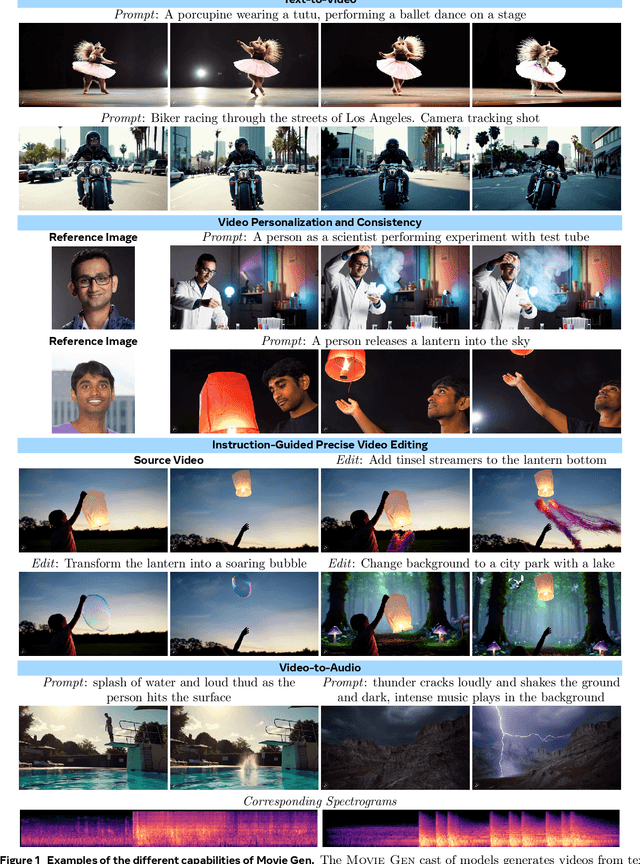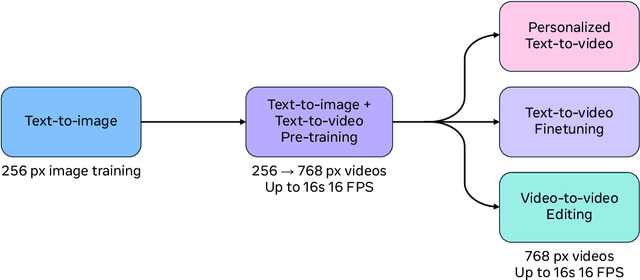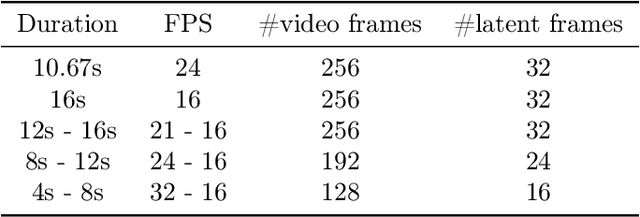Simran Motwani
Movie Gen: A Cast of Media Foundation Models
Oct 17, 2024



Abstract:We present Movie Gen, a cast of foundation models that generates high-quality, 1080p HD videos with different aspect ratios and synchronized audio. We also show additional capabilities such as precise instruction-based video editing and generation of personalized videos based on a user's image. Our models set a new state-of-the-art on multiple tasks: text-to-video synthesis, video personalization, video editing, video-to-audio generation, and text-to-audio generation. Our largest video generation model is a 30B parameter transformer trained with a maximum context length of 73K video tokens, corresponding to a generated video of 16 seconds at 16 frames-per-second. We show multiple technical innovations and simplifications on the architecture, latent spaces, training objectives and recipes, data curation, evaluation protocols, parallelization techniques, and inference optimizations that allow us to reap the benefits of scaling pre-training data, model size, and training compute for training large scale media generation models. We hope this paper helps the research community to accelerate progress and innovation in media generation models. All videos from this paper are available at https://go.fb.me/MovieGenResearchVideos.
Pixel-Space Post-Training of Latent Diffusion Models
Sep 26, 2024



Abstract:Latent diffusion models (LDMs) have made significant advancements in the field of image generation in recent years. One major advantage of LDMs is their ability to operate in a compressed latent space, allowing for more efficient training and deployment. However, despite these advantages, challenges with LDMs still remain. For example, it has been observed that LDMs often generate high-frequency details and complex compositions imperfectly. We hypothesize that one reason for these flaws is due to the fact that all pre- and post-training of LDMs are done in latent space, which is typically $8 \times 8$ lower spatial-resolution than the output images. To address this issue, we propose adding pixel-space supervision in the post-training process to better preserve high-frequency details. Experimentally, we show that adding a pixel-space objective significantly improves both supervised quality fine-tuning and preference-based post-training by a large margin on a state-of-the-art DiT transformer and U-Net diffusion models in both visual quality and visual flaw metrics, while maintaining the same text alignment quality.
Emu: Enhancing Image Generation Models Using Photogenic Needles in a Haystack
Sep 27, 2023



Abstract:Training text-to-image models with web scale image-text pairs enables the generation of a wide range of visual concepts from text. However, these pre-trained models often face challenges when it comes to generating highly aesthetic images. This creates the need for aesthetic alignment post pre-training. In this paper, we propose quality-tuning to effectively guide a pre-trained model to exclusively generate highly visually appealing images, while maintaining generality across visual concepts. Our key insight is that supervised fine-tuning with a set of surprisingly small but extremely visually appealing images can significantly improve the generation quality. We pre-train a latent diffusion model on $1.1$ billion image-text pairs and fine-tune it with only a few thousand carefully selected high-quality images. The resulting model, Emu, achieves a win rate of $82.9\%$ compared with its pre-trained only counterpart. Compared to the state-of-the-art SDXLv1.0, Emu is preferred $68.4\%$ and $71.3\%$ of the time on visual appeal on the standard PartiPrompts and our Open User Input benchmark based on the real-world usage of text-to-image models. In addition, we show that quality-tuning is a generic approach that is also effective for other architectures, including pixel diffusion and masked generative transformer models.
 Add to Chrome
Add to Chrome Add to Firefox
Add to Firefox Add to Edge
Add to Edge